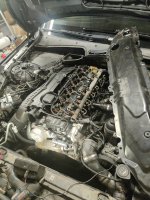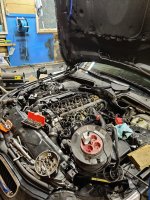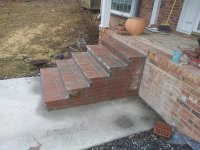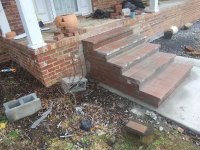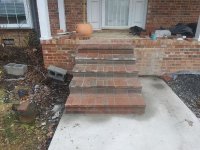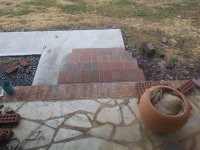It is my favourite lens, but I don't store it under my pillow or carry it in my cargo shorts pocket. 🙂
Even when it is in a camera bag hanging over my shoulder, I am certainly getting radiation above what is considered unavoidable "background". Approximately 1 µSv (microSievert) per hour, and a distance of a few inches.
However, a flight from NY to LA (or Brisbane to Perth, if you wish) doses a person with around 40 µSv - just to put it in perspective. Another way to look at it - 10 bananas contain 1 µSv.
More info - How much radiation is too much? A handy guide - Need to Know | PBS
Even when it is in a camera bag hanging over my shoulder, I am certainly getting radiation above what is considered unavoidable "background". Approximately 1 µSv (microSievert) per hour, and a distance of a few inches.
However, a flight from NY to LA (or Brisbane to Perth, if you wish) doses a person with around 40 µSv - just to put it in perspective. Another way to look at it - 10 bananas contain 1 µSv.
More info - How much radiation is too much? A handy guide - Need to Know | PBS
Last edited:
This time, it is an 800W microwave oven which started to make telltale sounds when it was operating. This fault sound was like that from a spark. At least, that was my first impression.
When I removed the metal cover, I inspected the inside for visible faults paying attention to make sure the physical coupling between the oven cavity and the magnetron did not permit leaky radiation. I did not want to expose myself to intense cooking radiation while testing. Testing showed it was not a spark which was causing the noise, but a cooling fan requiring some lubricating oil and a clean up. So, I removed the fan, disassembled it, cleaned its shaft and lubricated the holes for the shaft. Then, I reassembled everything and install the fan back in its original place. After powering for testing, the fault noise was gone, and the oven given yet another life!
The second repair is a slim blender which I use for soups and to prepare other foods. Blending some cooked mixed beans and other edible seeds, I was unfortunate not to notice one packet of beans/seeds contained a hard black stone which ended up in the cooking pot intended for blending. The hard black stone found its way in the cutting mouth of the blender damaging its blades. Very careful examination of the material, I found it was some kind of stainless steel which permitted me to use very fine sanding paper to resharp the damaged blades and to remove ugly scratches caused to the blender's mouth by the hard stone. The result was a nice looking blender mouth and blades.
When I removed the metal cover, I inspected the inside for visible faults paying attention to make sure the physical coupling between the oven cavity and the magnetron did not permit leaky radiation. I did not want to expose myself to intense cooking radiation while testing. Testing showed it was not a spark which was causing the noise, but a cooling fan requiring some lubricating oil and a clean up. So, I removed the fan, disassembled it, cleaned its shaft and lubricated the holes for the shaft. Then, I reassembled everything and install the fan back in its original place. After powering for testing, the fault noise was gone, and the oven given yet another life!
The second repair is a slim blender which I use for soups and to prepare other foods. Blending some cooked mixed beans and other edible seeds, I was unfortunate not to notice one packet of beans/seeds contained a hard black stone which ended up in the cooking pot intended for blending. The hard black stone found its way in the cutting mouth of the blender damaging its blades. Very careful examination of the material, I found it was some kind of stainless steel which permitted me to use very fine sanding paper to resharp the damaged blades and to remove ugly scratches caused to the blender's mouth by the hard stone. The result was a nice looking blender mouth and blades.
Last edited:
A toaster. A blender. Both cracking insulation on the power cords.
Yep, shopping for new ones.
Yep, shopping for new ones.
Send them to me! I guarantee, I can restore them for ten times their price.shortwave said:Yep, shopping for new ones.
Something I wish I could repair are my eyes. I know and understand the cause of focal distortion, but I have no medical means and knowledge to conduct a proper treatment. I have been suffering from gluten allergy since my early adolescence without knowing. I remember, several decades ago, I was taken to a medical doctor when I was about fifteen years of age, he suspected it was an allergy causing extensive damage to my vital organs, but he couldn't understand what it was! The gluten allergy had damaged my external parts of the corneas by local swelling that distorts the optical properties of the cornea. This has led to several, about seven, virtual focal points. The latter, are not aligned, but slightly displaced causing points to appear spread and distorted.
It is useless to go to an opthalmologist, as these are interested only in prescribing glasses, which hide the problem, rather than solving it. Glasses attentuate the vision issues, but they do not solve them. The focal distortions are still there and proper focusing is still inhibited: why should I pay very dearly for inadequate pseudo-solutions?
It is useless to go to an opthalmologist, as these are interested only in prescribing glasses, which hide the problem, rather than solving it. Glasses attentuate the vision issues, but they do not solve them. The focal distortions are still there and proper focusing is still inhibited: why should I pay very dearly for inadequate pseudo-solutions?
An ophthalmologist is interested in correcting vision. Be it with corrective lenses, laser surgery, or removing the eyeball, freezing it, and lathing the lens.
I had eye surgery at 6 months of age to correct a lazy eye and an astigmatism. My doctor was the chief ophthalmologist at The Hospital for Sick Children in Toronto. Zero cost out of pocket. I would have to pay for laser surgery the same way as I would have to pay for glasses or contacts, but the examinations and any scalpel based surgery would be no charge.
I had eye surgery at 6 months of age to correct a lazy eye and an astigmatism. My doctor was the chief ophthalmologist at The Hospital for Sick Children in Toronto. Zero cost out of pocket. I would have to pay for laser surgery the same way as I would have to pay for glasses or contacts, but the examinations and any scalpel based surgery would be no charge.
I take it as removing the eyeball means severing the optic nerve, which is made up of neural axons connecting directly with the visual area at the back of the brain and the brain stem. This means, reconnecting the optic nerve would mean repairing thousands upon thousands of severed axons. I cannot imagine how such a surgery, can be economically possible, given modern technological limitations. This is besides severed axons are not complete cells, and the cellural damage at the site of cut, would mean internal neural fluids and free organelles would flow out. Besides, retinal receptors are spatially organized, which means, severed axons would need to be connected to the neurons they belong to.kodabmx said:An ophthalmologist is interested in correcting vision. Be it with corrective lenses, laser surgery, or removing the eyeball, freezing it, and lathing the lens.
I meant to say remove the cornea, not the entire eyeball.
Shaping Restored Vision on a Corneal Lathe : Surgical Procedure Said to Pick Up Where Radial Keratotomy Leaves Off - Los Angeles Times
Shaping Restored Vision on a Corneal Lathe : Surgical Procedure Said to Pick Up Where Radial Keratotomy Leaves Off - Los Angeles Times
Will you look at that - my doctor is still working? I would have though he'd be retired or dead by now.
Department of Ophthalmology
Department of Ophthalmology
Last edited:
A Lafayette Bocama LA-224B, and a pair of Pioneer CS-51s. The Bocama has been completely re-capped, and the '51s have been freed of fibreglass stuffing and re-capped.
Listening to the setup right now. Sounds really good.
Listening to the setup right now. Sounds really good.
Oh! And I just discovered that I still had the 8 ohm switch on for 16ohm speakers. Even better still now.
3 minidisc decks, 2 x 470 and a 440, belts only and now full working order
still get md decks in for repair at least a few a year😉
I've just ordered a belt for mine as I couldn't source anything suitable locally such as O rings etc.
I did wonder about watch back replacement gaskets as some of those are not that different thickness wise.
I did wonder about watch back replacement gaskets as some of those are not that different thickness wise.
Does a B1Korg count?
It worked for a week and sounded fantastic. The heater filament then decided to snap. Great fun desoldering that device! All is working nicely again.
I have to admit to being rather nervous when I switched it back on after putting a new one in. At £50 a pop (literally), I made sure that there was no debris on the board before reinstalling it.
Just prior to that, I repaired the fob watch that my son gave me as a graduation present. It has been repaired several times over the years, the internal mechanism and the fob strap have both been replaced. Only the bezel and face are original, so it's slowly turning in to Trigger's broom (or Theseus' ship, if you prefer classical references).
It worked for a week and sounded fantastic. The heater filament then decided to snap. Great fun desoldering that device! All is working nicely again.
I have to admit to being rather nervous when I switched it back on after putting a new one in. At £50 a pop (literally), I made sure that there was no debris on the board before reinstalling it.
Just prior to that, I repaired the fob watch that my son gave me as a graduation present. It has been repaired several times over the years, the internal mechanism and the fob strap have both been replaced. Only the bezel and face are original, so it's slowly turning in to Trigger's broom (or Theseus' ship, if you prefer classical references).
Yesterday I repaired my BMW 118d.
I replaced an outgoing drive shaft and the wheel carrier.
Not a fun job.
Today I replaced the glow plugs and glow plug controller in my 525d.
Tomorrow I will replace the main thermostat and egr thermostat before putting the car back together.
I'm a little short to work on 5-series, I have stretched so much to reach components in the middle and back of the engine bay that I lost feeling in both legs. 😛
I replaced an outgoing drive shaft and the wheel carrier.
Not a fun job.
Today I replaced the glow plugs and glow plug controller in my 525d.
Tomorrow I will replace the main thermostat and egr thermostat before putting the car back together.
I'm a little short to work on 5-series, I have stretched so much to reach components in the middle and back of the engine bay that I lost feeling in both legs. 😛
Attachments
Just where shall I begin? In a three week window...our Washer threw out failure code "E1", not enough water...OK, climb to the top of our "back house, peek in the top of the water tank, firstly, the cement composite lid was cracked in four places & fell apart, took out one quarters worth, yep, the float valve wasn't working...replaced that, Teflon tape for the screw threads...since the lid was so old, of course nobody makes such anymore. Found a metal fab shop who fabricated a nice peaked top for it. 80mm cuts, spaced 80mm all around, folded down, drilled & secured in place with mechanics wire.
Didn't stop the washer malfunction, reading further, the code can also be other issues, tightened up the drive belt, OK, that works.
Just about the same time I was done with that, loaded up the dryer & pushed the start button...nothing, no motor start, no changing of functions...nothing. First I started with those damn thermal fuses, number one, OK, number two, OK...door close switch, com, no, nc ...all OK, went to the computerized control board, found the membrane switch pin-out, measure the button, yikes, ten ohms?? reading more, anything less than 100 ohms is considered "closed", conducting???
Put the front half of the thing back together, hoping to monitor the motor run relay...as the belt tension switch & the motor itself was further down the possible faults listings...Whadda ya know...I guess the thing was getting scared of me poking around & decided to work OK for me...
During all this the "out in the rain" 220V outlet decided to flame-on & pop the breaker to the front house...the same breaker that was exposed in the rainstorm right next to the outlet...so I see the flame hole in the outlet, with the breaker open, I clip the lines & remove the outlet, and in a driving rainstorm...I see the news-flash in my mind, "Man electrocuted in rainstorm"...I find my pair of long needle-nose with not much insulation & trip the breaker "On"...under an umbrella, "A most dangerous game".
--------------------------------------------------------------------Rick....
Didn't stop the washer malfunction, reading further, the code can also be other issues, tightened up the drive belt, OK, that works.
Just about the same time I was done with that, loaded up the dryer & pushed the start button...nothing, no motor start, no changing of functions...nothing. First I started with those damn thermal fuses, number one, OK, number two, OK...door close switch, com, no, nc ...all OK, went to the computerized control board, found the membrane switch pin-out, measure the button, yikes, ten ohms?? reading more, anything less than 100 ohms is considered "closed", conducting???
Put the front half of the thing back together, hoping to monitor the motor run relay...as the belt tension switch & the motor itself was further down the possible faults listings...Whadda ya know...I guess the thing was getting scared of me poking around & decided to work OK for me...
During all this the "out in the rain" 220V outlet decided to flame-on & pop the breaker to the front house...the same breaker that was exposed in the rainstorm right next to the outlet...so I see the flame hole in the outlet, with the breaker open, I clip the lines & remove the outlet, and in a driving rainstorm...I see the news-flash in my mind, "Man electrocuted in rainstorm"...I find my pair of long needle-nose with not much insulation & trip the breaker "On"...under an umbrella, "A most dangerous game".
--------------------------------------------------------------------Rick....
Last edited:
In the restoration of this old house , last year, I had to have it completely trenched out, down to the footings to install drains and fix the drainage issues. The sidewalks had collapsed and were tilted toward the house compounding the drainage issues and had to be replaced and the front porch steps had collapsed. Fortunately there is a trailer park that was building up ground and needed fill. The old broken concrete and masonry was actually recycled.😀
, last year, I had to have it completely trenched out, down to the footings to install drains and fix the drainage issues. The sidewalks had collapsed and were tilted toward the house compounding the drainage issues and had to be replaced and the front porch steps had collapsed. Fortunately there is a trailer park that was building up ground and needed fill. The old broken concrete and masonry was actually recycled.😀
Last year after trying my hand at building up a new block retaining wall, I decided to try some carpentry and construct a new deck.
So I've had more time lately, and I've been busy restoring a bathroom, and doing some demolition elsewhere. After installing and finishing the new French doors leading out to the deck, I finally got around to building the front porch steps back. Frankly, the broken door and bathroom restoration and functionality took a priority over the porch steps, as none of the fixtures worked and the septic drain field had to be replaced too.
After installing and finishing the new French doors leading out to the deck, I finally got around to building the front porch steps back. Frankly, the broken door and bathroom restoration and functionality took a priority over the porch steps, as none of the fixtures worked and the septic drain field had to be replaced too. let's just say that was a mess in the basement that I'd rather not talk about. A power washer, bleach, and an old shop vac was involved. It wasnt pleasant.
let's just say that was a mess in the basement that I'd rather not talk about. A power washer, bleach, and an old shop vac was involved. It wasnt pleasant. But I could walk around back to enter the house, and could probably go around back for the other buisness too but would rather not.🙄 haha.
But I could walk around back to enter the house, and could probably go around back for the other buisness too but would rather not.🙄 haha.
Masonry is kind of fun but you have to be accurate. Measure many times, recheck with levels often. With wood and screws, you can disassemble and fix minor errors. The secret is keeping the right consistency in the mortar, to work with it. Getting it to stick where you want it to, being able to shape it. You can feel when it's right and when not. A problem with brick and mortar, F-ups just stay as F-ups. Lol. It takes me more time, I'm not a brick mason. Anyway, unlike the old brick steps, these have concrete under them. The old steps were very steep in slope. I wanted a much shallower slope, so each step is 12" deep, 5 3/8" tall. Cinder blocks and bricks are built up under the steps.
I found an old roll of stainless steel screen in the basement. I used it as a mat under the paving blocks as a backer for the cement to fill around the blocks. My uncle built onto his house about ten years ago and had a couple of pallets of bricks leftover sitting outside taking space and collecting spiders. One of pavers and one of builders. He sold them to me for the cost of fixing the power supply in his wine cooler. Which was nothing, the TL494 controller had a bad decoupling capacitor. So for a nothing 1uF capacitor and about 120Kilos of mortar, and time which has been stalled due to winter weather🙄 I got my porch steps back.🙂 The railings are next but unfortunately winter is back. It barely broke freezing today.
 , last year, I had to have it completely trenched out, down to the footings to install drains and fix the drainage issues. The sidewalks had collapsed and were tilted toward the house compounding the drainage issues and had to be replaced and the front porch steps had collapsed. Fortunately there is a trailer park that was building up ground and needed fill. The old broken concrete and masonry was actually recycled.😀
, last year, I had to have it completely trenched out, down to the footings to install drains and fix the drainage issues. The sidewalks had collapsed and were tilted toward the house compounding the drainage issues and had to be replaced and the front porch steps had collapsed. Fortunately there is a trailer park that was building up ground and needed fill. The old broken concrete and masonry was actually recycled.😀 Last year after trying my hand at building up a new block retaining wall, I decided to try some carpentry and construct a new deck.
So I've had more time lately, and I've been busy restoring a bathroom, and doing some demolition elsewhere.
 After installing and finishing the new French doors leading out to the deck, I finally got around to building the front porch steps back. Frankly, the broken door and bathroom restoration and functionality took a priority over the porch steps, as none of the fixtures worked and the septic drain field had to be replaced too.
After installing and finishing the new French doors leading out to the deck, I finally got around to building the front porch steps back. Frankly, the broken door and bathroom restoration and functionality took a priority over the porch steps, as none of the fixtures worked and the septic drain field had to be replaced too. let's just say that was a mess in the basement that I'd rather not talk about. A power washer, bleach, and an old shop vac was involved. It wasnt pleasant.
let's just say that was a mess in the basement that I'd rather not talk about. A power washer, bleach, and an old shop vac was involved. It wasnt pleasant. But I could walk around back to enter the house, and could probably go around back for the other buisness too but would rather not.🙄 haha.
But I could walk around back to enter the house, and could probably go around back for the other buisness too but would rather not.🙄 haha. Masonry is kind of fun but you have to be accurate. Measure many times, recheck with levels often. With wood and screws, you can disassemble and fix minor errors. The secret is keeping the right consistency in the mortar, to work with it. Getting it to stick where you want it to, being able to shape it. You can feel when it's right and when not. A problem with brick and mortar, F-ups just stay as F-ups. Lol. It takes me more time, I'm not a brick mason. Anyway, unlike the old brick steps, these have concrete under them. The old steps were very steep in slope. I wanted a much shallower slope, so each step is 12" deep, 5 3/8" tall. Cinder blocks and bricks are built up under the steps.
I found an old roll of stainless steel screen in the basement. I used it as a mat under the paving blocks as a backer for the cement to fill around the blocks. My uncle built onto his house about ten years ago and had a couple of pallets of bricks leftover sitting outside taking space and collecting spiders. One of pavers and one of builders. He sold them to me for the cost of fixing the power supply in his wine cooler. Which was nothing, the TL494 controller had a bad decoupling capacitor. So for a nothing 1uF capacitor and about 120Kilos of mortar, and time which has been stalled due to winter weather🙄 I got my porch steps back.🙂 The railings are next but unfortunately winter is back. It barely broke freezing today.

Last edited:
Brick by brick......day by day....🙄
Attachments
-
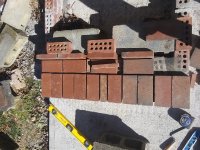 20201119_132215_resize_2.jpg196.8 KB · Views: 120
20201119_132215_resize_2.jpg196.8 KB · Views: 120 -
 20201121_141617_resize_90.jpg186.8 KB · Views: 119
20201121_141617_resize_90.jpg186.8 KB · Views: 119 -
 20201121_162121_resize_24.jpg180.8 KB · Views: 126
20201121_162121_resize_24.jpg180.8 KB · Views: 126 -
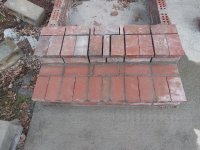 20201122_161726_resize_87.jpg149.1 KB · Views: 76
20201122_161726_resize_87.jpg149.1 KB · Views: 76 -
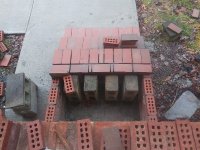 20201130_145141_resize_78.jpg146.1 KB · Views: 79
20201130_145141_resize_78.jpg146.1 KB · Views: 79 -
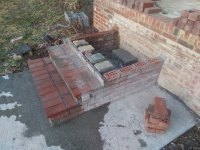 20201126_171034_resize_39.jpg138.9 KB · Views: 77
20201126_171034_resize_39.jpg138.9 KB · Views: 77 -
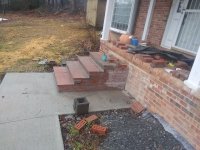 20201214_120833_resize_50.jpg143.5 KB · Views: 73
20201214_120833_resize_50.jpg143.5 KB · Views: 73 -
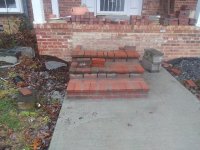 20201130_145209_resize_21.jpg135.3 KB · Views: 72
20201130_145209_resize_21.jpg135.3 KB · Views: 72
Last edited:
- Home
- Member Areas
- The Lounge
- What did you last repair?
